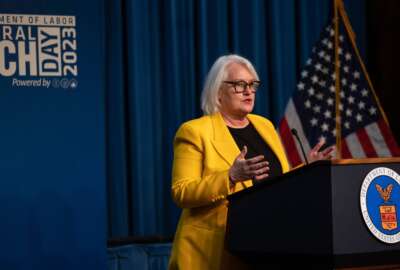President Barack Obama is calling for a review of how agencies buy technology in light of the HealthCare.gov debacle.
During a campaign event in Washington Monday night, the President said he’s frustrated with the problems with the Affordable Care Act portal and some of it goes back to federal procurement rules.
“And it’s inexcusable, and there are a whole range of things that we’re going to need to do once we get this fixed — to talk about federal procurement when it comes to IT and how that’s organized,” he said.
One of the key figures in fixing federal IT procurement will be Steve VanRoekel, the federal chief information officer. VanRoekel, who spoke in late October about the shortcomings of HealthCare.gov at the ACT-IAC Executive Leadership Conference in Williamsburg, Va., said like many failures in industry there are teachable moments for the government.
VanRoekel said there are opportunities for procurement reform and he would work with the Office of Federal Procurement Policy.
“I think the way we implement technology, the speed at which technology moves, often times it’s challenging to drive innovation in the context of cycles that take 6-9 months, a year or more to implement technology, and by the time you get the procurement done, the technology will change,” VanRoekel said during a press conference after his speech. “But procurement’s not the only thing. It takes great governance, great management, an eye toward cybersecurity, all of these things have to come into concert. It takes a village. It’s not just the CIO’s role to think about the implementation of these things. It’s the CFO, the CAO, the deputy and the secretary of these departments have to step up and see value of these investments.”
Much of what the Office of Management and Budget has been pushing over the last five years around IT reform has focused on changing old habits to lower risk. The 25-point IT reform plan called for the use of agile methodology for IT projects. It called for the move to cloud computing to make expansion and change easier. And it called for a cadre of IT acquisition experts to help agencies with complicated programs.
VanRoekel said there are aspects of the process that make it hard to move at the speed that’s necessary.
“We need to look at these things in this context as a teachable moment and think about how we can continue to evolve and drive these systems forward,” he said.
Along with the President’s call for change in IT procurement, the House Armed Services Committee set up a working group to look at reforming the acquisition process at the Defense Department.
As part of that evolution of IT, VanRoekel said he’s focusing on a new priority for 2014, and expanding a current one.
He said training and the redeployment of IT personnel because of consolidation will be big change for federal employees.
“Right now, we’re still at the ideation stage of what is the art of the possible, and starting conversations with folks on what would it take,” VanRoekel said. “Doing things like market pay on a specific slice of government is really hard just because it’s easy to justify many parts of government, think of doctors in Veterans Affairs hospitals to cybersecurity experts. There’s a broad spectrum there of many, many people who could entertain a much, much larger salary outside the walls of government. We need to think about the complete package and think about what we are doing from the employee standpoint to drive the best and brightest and attract them to government.”
He added OMB is considering rotational opportunities both inside and out of government.
In addition to personnel, VanRoekel said he’s expanding the priority to innovate in order to focus more on effectiveness.
He said driving cost savings through new ways of buying will continue to be important, but he also wants agencies to take a hard look at how effective their systems and apps are at serving citizens.
“Today in the federal government, we treat cell phones, mobile devices and computers differently. Those are managed differently. They are secured differently. We are very close, I’d say in the next 5-to-10 years at least in the private sector and you are starting to see that with the Microsoft Surface, the iPad and the Droid tablets starting to blend in and the worlds starting to collide,” VanRoekel said. “Those worlds are coming together and blending in a way that will change the dynamic. That will have both a productivity impact on government from standpoint of how we do our work. It will have a security impact in how we think about security. And more importantly, much like we’ve seen with smart devices and iPhones, it will change citizen expectations of government. It’s that force that tends to be the strongest one in driving change in government.”
RELATED STORIES:
VanRoekel offers silver lining in HealthCare.gov debacle
White House pushes $2B increase in IT spending
Cloud changing agency IT workforce needs
Copyright
© 2024 Federal News Network. All rights reserved. This website is not intended for users located within the European Economic Area.






